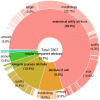The Ontology of Biological Attributes (OBA)-computational traits for the life sciences
- PMID: 37076585
- PMCID: PMC10382347
- DOI: 10.1007/s00335-023-09992-1
The Ontology of Biological Attributes (OBA)-computational traits for the life sciences
Abstract
Existing phenotype ontologies were originally developed to represent phenotypes that manifest as a character state in relation to a wild-type or other reference. However, these do not include the phenotypic trait or attribute categories required for the annotation of genome-wide association studies (GWAS), Quantitative Trait Loci (QTL) mappings or any population-focussed measurable trait data. The integration of trait and biological attribute information with an ever increasing body of chemical, environmental and biological data greatly facilitates computational analyses and it is also highly relevant to biomedical and clinical applications. The Ontology of Biological Attributes (OBA) is a formalised, species-independent collection of interoperable phenotypic trait categories that is intended to fulfil a data integration role. OBA is a standardised representational framework for observable attributes that are characteristics of biological entities, organisms, or parts of organisms. OBA has a modular design which provides several benefits for users and data integrators, including an automated and meaningful classification of trait terms computed on the basis of logical inferences drawn from domain-specific ontologies for cells, anatomical and other relevant entities. The logical axioms in OBA also provide a previously missing bridge that can computationally link Mendelian phenotypes with GWAS and quantitative traits. The term components in OBA provide semantic links and enable knowledge and data integration across specialised research community boundaries, thereby breaking silos.
© 2023. The Author(s).
Conflict of interest statement
The authors declare no competing interests.
Figures




Update of
-
The Ontology of Biological Attributes (OBA) - Computational Traits for the Life Sciences.bioRxiv [Preprint]. 2023 Jan 27:2023.01.26.525742. doi: 10.1101/2023.01.26.525742. bioRxiv. 2023. Update in: Mamm Genome. 2023 Sep;34(3):364-378. doi: 10.1007/s00335-023-09992-1. PMID: 36747660 Free PMC article. Updated. Preprint.
References
-
- Balhoff JP et al (2022) Ubergraph: integrating OBO ontologies into a unified semantic graph. https://icbo-conference.github.io/icbo2022/papers/ICBO-2022_paper_5005.pdf

